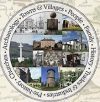John Cuninghame, Laird of Craigends, when he was in his mid-fifties, wrote a personal diary covering the years 1814-15. More than one hundred years later, in 1919, the diary was published by James Durham, his great-grandson. As one would expect, the dairy includes entries about his estate and business duties including haymaking, sheep shearing, pruning vines, checking his hothouse, buying Highland cattle at the June Thorn Fair in 1814 and at Johnstone Fair the following year, engaging and dismissing staff, collecting rent from his tenants, attending to his property in Port Glasgow and going to Paisley to ‘bank my West India income’. There were also entries noting his public duties such as attending heritors and session meetings to distribute the poor funds, inspecting Hardgate Toll and attending meetings concerning local toll roads in need of repair or alteration.
But business entries are far outnumbered by numerous entries about his health and the weather. Although John Cuninghame was a devout Christian, either a minor ailment or inclement weather seems always to have occurred on a Saturday justifying his non-attendance at church the following day. He suffered from numerous minor ailments and, more seriously, from gout. The ‘running off of the last of the wine’ (58 dozen and two bottles) in March, 1814, may have contributed to his gout! However, despite his painful illness he still frequently managed to go hunting with friends at Formakin, Barrochan Mill and Kilmacolm on his favourite horse, Empress.
John Cuninghame of Craigends and his wife Margaret were married in 1800 and by 1815 and had eleven children. Their family social circle, as one would expect, was largely confined to local gentry of his own class and Mr John Monteith, the Houston and Killallan minister. Mrs Monteith, ‘a kind good woman’ was a close friend of Margaret. She even stayed over at Craigends to help when new babies were born.
Other family friends mentioned in the diary include the Flemings of Barochan, Lady Stewart at Torr, the Porterfields of Duchal, the Alexanders of Soutbar, Sir John and Lady Maxwell of Pollock, the Napiers of Blackstoun, Mr Douglas (Kilbachan parish minister) and the Napiers of Milliken, who at that time were renting Alexander Spiers’s Glentyan House in Kilbarchan. On a visit to Glentyan, John Cunninghame was introduced to William Milliken Napier’s new bride, Elizabeth Stirling, whom he described as ‘very agreeable, tho’ not such a beauty as I had been led to think she was’. These families frequently visited each other for dinner. The main modes of transport used to visit friends were horseback or private horse and chaise for short distances, post horses on occasion for longer journeys and boats on the Johnstone Canal.
John Cuninghame had a keen interest in the lives of his children. This personal involvement of a father with his children seems more in keeping with the present day than the early nineteenth century. Entries in the diary record the birth of his youngest son, Boyd, on 11th March 1814, with intimate details on problems with the wet nurse, and an entry on the nineteenth of March saying ‘Mrs C slept well. Baby going finely’. The diary details John Cuninghame’s arrangements for the younger children to go on holiday to Largs ‘for ‘sea bathing’. He and his wife journeyed to Largs at the end of May to book a holiday house at the cost of £11 for the season. He also noted calling the doctor when the children had chickenpox, when Lillie cut and bruised her cheek and when Willie fell from a horse. Another entry mentions taking his eight year old daughter, Fanny, to Paisley to have a haircut. His older boys were educated in Edinburgh under ‘the care and instruction’ of Robert Smith until December 1814, when he became the minister in Lochwinnoch, and was replaced by David Brown. John Cuninghame mentions sending a watch to his eldest son, thirteen year old Willie, in Edinburgh.
The diary surprisingly makes no mention of politics or the Battle of Waterloo. John Cuninghame’s Diary is simply a very ordinary day to day account of the family life of a country laird who suffered from ill health, loved his family and attended to his immediate estate and public duties. He died in 1822 and was buried in Kilbarchan. His gravestone is displayed high on the wall inside the entrance tower of Kilbarchan old Parish Church.
© 2014, Helen Calcluth

